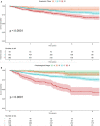Associations Between Clinical Outcomes and a Recently Proposed Adult Congenital Heart Disease Anatomic and Physiological Classification System
- PMID: 34482709
- PMCID: PMC8649495
- DOI: 10.1161/JAHA.120.021345
Associations Between Clinical Outcomes and a Recently Proposed Adult Congenital Heart Disease Anatomic and Physiological Classification System
Abstract
Background American Heart Association and American College of Cardiology consensus guidelines introduce an adult congenital heart disease anatomic and physiological (AP) classification system. We assessed the association between AP classification and clinical outcomes. Methods and Results Data were collected for 1000 outpatients with ACHD prospectively enrolled between 2012 and 2019. AP classification was assigned based on consensus definitions. Primary outcomes were (1) all-cause mortality and (2) a composite of all-cause mortality or nonelective cardiovascular hospitalization. Cox regression models were developed for AP classification, each component variable, and additional clinical models. Discrimination was assessed using the Harrell C statistic. Over a median follow-up of 2.5 years (1.4-3.9 years), the composite outcome occurred in 185 participants, including 49 deaths. Moderately or severely complex anatomic class (class II/III) and severe physiological stage (stage D) had increased risk of the composite outcome (AP class IID and IIID hazard ratio, 4.46 and 3.73, respectively, versus IIC). AP classification discriminated moderately between patients who did and did not suffer the composite outcome (C statistic, 0.69 [95% CI, 0.67-0.71]), similar to New York Heart Association functional class and NT-proBNP (N-terminal pro-B-type natriuretic peptide); it was more strongly associated with mortality (C statistic, 0.81 [95% CI, 0.78-0.84]), as were NT-proBNP and functional class. A model with AP class and NT-proBNP provided the strongest discrimination for the composite outcome (C statistic, 0.73 [95% CI, 0.71-0.75]) and mortality (C statistic, 0.85 [95% CI, 0.82-0.88]). Conclusions The addition of physiological stage modestly improves the discriminative ability of a purely anatomic classification, but simpler approaches offer equivalent prognostic information. The AP system may be improved by addition of key variables, such as circulating biomarkers, and by avoiding categorization of continuous variables.
Keywords: adult congenital heart disease; classification; cohort study; congenital heart disease; guidelines; mortality; outcomes.
Conflict of interest statement
None.
Figures




References
-
- Gilboa SM, Devine OJ, Kucik JE, Oster ME, Riehle‐Colarusso T, Nembhard WN, Xu P, Correa A, Jenkins K, Marelli AJ. Congenital heart defects in the United States: estimating the magnitude of the affected population in 2010. Circulation. 2016;134:101–109. DOI: 10.1161/CIRCULATIONAHA.115.019307. - DOI - PMC - PubMed
Publication types
MeSH terms
Grants and funding
LinkOut - more resources
Full Text Sources
Medical
Research Materials

